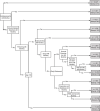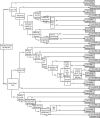Predicting Sex-Specific Nonfatal Suicide Attempt Risk Using Machine Learning and Data From Danish National Registries
- PMID: 33877265
- PMCID: PMC8796814
- DOI: 10.1093/aje/kwab112
Predicting Sex-Specific Nonfatal Suicide Attempt Risk Using Machine Learning and Data From Danish National Registries
Abstract
Suicide attempts are a leading cause of injury globally. Accurate prediction of suicide attempts might offer opportunities for prevention. This case-cohort study used machine learning to examine sex-specific risk profiles for suicide attempts in Danish nationwide registry data. Cases were all persons who made a nonfatal suicide attempt between 1995 and 2015 (n = 22,974); the subcohort was a 5% random sample of the population at risk on January 1, 1995 (n = 265,183). We developed sex-stratified classification trees and random forests using 1,458 predictors, including demographic factors, family histories, psychiatric and physical health diagnoses, surgery, and prescribed medications. We found that substance use disorders/treatment, prescribed psychiatric medications, previous poisoning diagnoses, and stress disorders were important factors for predicting suicide attempts among men and women. Individuals in the top 5% of predicted risk accounted for 44.7% of all suicide attempts among men and 43.2% of all attempts among women. Our findings illuminate novel risk factors and interactions that are most predictive of nonfatal suicide attempts, while consistency between our findings and previous work in this area adds to the call to move machine learning suicide research toward the examination of high-risk subpopulations.
Keywords: Denmark; National Registry; machine learning; prediction; suicide attempts.
© The Author(s) 2021. Published by Oxford University Press on behalf of the Johns Hopkins Bloomberg School of Public Health. All rights reserved. For permissions, please e-mail: journals.permissions@oup.com.
Figures




Comment in
-
Invited Commentary: New Directions in Machine Learning Analyses of Administrative Data to Prevent Suicide-Related Behaviors.Am J Epidemiol. 2021 Dec 1;190(12):2528-2533. doi: 10.1093/aje/kwab111. Am J Epidemiol. 2021. PMID: 33877322 Free PMC article.
-
Gradus et al. Respond to "Machine Learning and Suicide Prevention: New Directions".Am J Epidemiol. 2021 Dec 1;190(12):2534-2535. doi: 10.1093/aje/kwab113. Am J Epidemiol. 2021. PMID: 33878158 Free PMC article. No abstract available.
Similar articles
-
Predictors of nonfatal suicide attempts within 30 days of discharge from psychiatric hospitalization: Sex-specific models developed using population-based registries.J Affect Disord. 2022 Jun 1;306:260-268. doi: 10.1016/j.jad.2022.03.034. Epub 2022 Mar 16. J Affect Disord. 2022. PMID: 35304235 Free PMC article.
-
Prediction of Sex-Specific Suicide Risk Using Machine Learning and Single-Payer Health Care Registry Data From Denmark.JAMA Psychiatry. 2020 Jan 1;77(1):25-34. doi: 10.1001/jamapsychiatry.2019.2905. JAMA Psychiatry. 2020. PMID: 31642880 Free PMC article.
-
Using machine learning to predict suicide in the 30 days after discharge from psychiatric hospital in Denmark.Br J Psychiatry. 2021 Aug;219(2):440-447. doi: 10.1192/bjp.2021.19. Br J Psychiatry. 2021. PMID: 33653425 Free PMC article.
-
Prediction of suicide attempts among persons with depression: a population-based case cohort study.Am J Epidemiol. 2024 Jun 3;193(6):827-834. doi: 10.1093/aje/kwad237. Am J Epidemiol. 2024. PMID: 38055633 Free PMC article.
-
Prevention of suicide and attempted suicide in Denmark. Epidemiological studies of suicide and intervention studies in selected risk groups.Dan Med Bull. 2007 Nov;54(4):306-69. Dan Med Bull. 2007. PMID: 18208680 Review.
Cited by
-
NSSI questionnaires revisited: A data mining approach to shorten the NSSI questionnaires.PLoS One. 2023 Apr 21;18(4):e0284588. doi: 10.1371/journal.pone.0284588. eCollection 2023. PLoS One. 2023. PMID: 37083960 Free PMC article.
-
County-level estimates of suicide mortality in the USA: a modelling study.Lancet Public Health. 2023 Mar;8(3):e184-e193. doi: 10.1016/S2468-2667(22)00290-0. Epub 2023 Jan 23. Lancet Public Health. 2023. PMID: 36702142 Free PMC article.
-
Role of machine learning algorithms in suicide risk prediction: a systematic review-meta analysis of clinical studies.BMC Med Inform Decis Mak. 2024 May 27;24(1):138. doi: 10.1186/s12911-024-02524-0. BMC Med Inform Decis Mak. 2024. PMID: 38802823 Free PMC article.
-
Weak and unstable prediction of personality from the structural connectome.Imaging Neurosci (Camb). 2025 Jan 3;3:imag_a_00416. doi: 10.1162/imag_a_00416. eCollection 2025. Imaging Neurosci (Camb). 2025. PMID: 40800995 Free PMC article.
-
Identifying most important predictors for suicidal thoughts and behaviours among healthcare workers active during the Spain COVID-19 pandemic: a machine-learning approach.Epidemiol Psychiatr Sci. 2025 May 8;34:e28. doi: 10.1017/S2045796025000198. Epidemiol Psychiatr Sci. 2025. PMID: 40340775 Free PMC article.
References
-
- World Health Organization . Mental Health and substance abuse: suicide data. World Health Organization. http://www.who.int/mental_health/prevention/suicide/suicideprevent/en/. Accessed August 20, 2019.
-
- Biering-Sørensen F, Pedersen W, Müller PG. Spinal cord injury due to suicide attempts. Paraplegia. 1992;30(2):139–144. - PubMed
-
- Han B, Kott PS, Hughes A, et al. Estimating the rates of deaths by suicide among adults who attempt suicide in the United States. J Psychiatr Res. 2016;77:125–133. - PubMed
Publication types
MeSH terms
Grants and funding
LinkOut - more resources
Full Text Sources
Other Literature Sources
Miscellaneous

